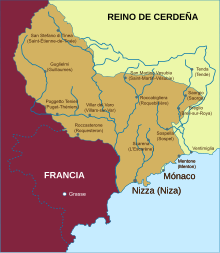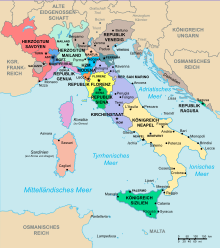Nice county
The county of Nice ( French Comté de Nice , Italian Contea di Nizza ), which included the city of Nice and its surroundings, was originally part of Provence . From 1388 - with an interruption from 1793 to 1814 - it belonged to the domain of the House of Savoy , in 1860 it fell to France . It forms the main part of the Alpes-Maritimes ( Maritime Alps ) department in the Provence-Alpes-Côte d'Azur region .
history
1380 adopted the childless Queen Joan I of Naples (around 1326-1382), who was also Countess of Provence , Louis I of Anjou (1336-1384), the brother of the French King Charles V , and set him as her successor firmly. She passed over Karl von Durazzo (1345–1386), whom she had previously adopted as a child with the same intention.
The war of succession to the throne, which developed logically, was used by Count Amadeus VII of Savoy to realize the long sought access to the sea for his property. He began negotiations with Jean Grimaldi, governor of Nice and eastern Provence , with the result of the Dédition de Nice à la Savoie (1388), with which the city and its surroundings ( Puget-Théniers , the Tinée and Vésubie valleys ) when Terres Neuves de Provence were annexed to Savoy and administratively merged with the valley of the Ubaye .
Savoy, which was elevated to a duchy in 1416, was at that time a powerful state with a strong army, wealthy and well organized, in contrast to the rest of Provence. With the approval of the population, the Savoyard military moved in and Nice became the residence of a military and civilian Savoyard governor.
The French barons - with the exception of the Grimaldi von Beuil and the Laskaris von Tende - emigrated and settled on the right bank of the border river Var (only the municipality of Gattières on the western bank of the Var belonged to the county), whereupon Amadeus VII acquired a new nobility for whom terres neuves created.
Monaco had its independence confirmed in 1489 by the French King and the Duke of Savoy. The terres neuves de Provence were given the name comté de Nice ( County of Nice ) in 1526 , a purely administrative designation and therefore not a feudal title.
In 1543 Nice was besieged by French troops of the Duke of Enghien and the Turkish fleet of the corsair Khair ad-Din Barbarossa as a result of the alliance between Francis I of France and the Turkish Sultan Suleiman the Magnificent against Emperor Charles V. Although the city was conquered after 20 days, the fleet withdrew due to the resistance of the last defenders of the castle (→ Siege of Nice (1543) ).
Duke Charles Emanuel I of Savoy made Nice a free port in 1614 and set up a senate. The uprising of the Count von Beuil was put down in 1621 - the county of Nice lived in stability, in contrast to the rest of Provence, where such revolts were common. The military conflict between France and Savoy around 1700 also affected Nice, which was occupied by France in the War of Palatinate Succession from 1691 to 1697 and in the War of Spanish Succession from 1707 to 1713 . In 1720 the Duchy of Savoy became part of the Kingdom of Sardinia , making the county of Nice part of Sardinia-Piedmont.
In 1769, in the Treaty of Turin , the borders between Nice and the rest of Provence were redefined. Gattières and the right bank of the Estéron came to France, Guillaumes and La Penne to Savoy.
At the beginning of the French Revolution in 1789, Nice was a royalist center. On September 29, 1792 and January 31, 1793, the army of the young republic marched into Nice, the convention ordered the annexation of the county to the republic and the creation of the Alpes-Maritimes department . The "Barbets", the regional royalists, fought against the French occupation in the mountains.
The county was re-established on April 23, 1814 under the rule of the King of Sardinia. To compensate for the influence of Genoa , annexed by Sardinia-Piedmont in 1815, the Nice region was created, which consisted of the Province of Nice, the Province of San Remo and the Province of Oneglia , an administrative reform that dissolved the Margraviate of Dolceacqua , the same as old as the county of Nice. The Principality of Monaco , which was also rebuilt under French protection in 1814, submitted to the protection of Sardinia in 1815. Menton and Roquebrune rose against the rest of the principality in 1848 and became free cities under the administration of the House of Savoy
In 1859, France and Sardinia concluded an alliance with the aim of driving Austria out of northern Italy . For this France should (among other things) be rewarded with the county of Nice. In the same year Napoléon III signed . the Peace of Villafranca di Verona , which ended the Italian campaign again. As a result, Veneto remained Austrian while Great Britain opposed the integration of Savoy and Nice into France.
In 1860, Napoleon and Victor Emanuel II signed the Treaty of Turin , which provided for the annexation of Nice (and Savoy ) to France with the consent of its residents (but also for Tende , La Brigue and Mollières (now incorporated by Valdeblore ) to remain with Italy, because this was the king's preferred hunting ground - these three communities only came to France as a result of the Second World War ). At the plebiscite , which was also held in Menton and Roquebrune, 25,743 eligible voters voted for and 260 against the annexation to France.
On June 14, 1860, French troops marched into Nice. The previous county of Nice, consisting of the arrondissements of Nice and Puget-Théniers, was expanded to include the arrondissement of Grasse and (again) made into the Alpes-Maritimes department. The Principality of Monaco was no longer under the protection of Sardinia, but again under that of France.
The nobility of the county continued to orientate themselves towards Italy due to the centuries-old connections, so that, for example, the Thaon de Revel family was able to provide two ministers under Benito Mussolini .
The Arrondissement of Puget-Théniers was merged with the Arrondissement of Nice in 1926 for cost reasons. The council assembly of the new arrondissement was called Parlement du comté de Nice , a name that was only given up with the liberation at the end of the Second World War.
On the ecclesiastical side, the Bishop of Nice , who was subordinate to the Archbishop of Genoa, was subordinated to the Archbishop of Aix after 1860 . In 1886 the Arrondissement of Grasse (with the exception of the island of Saint-Honorat ) was detached from the Diocese of Fréjus and added to the Diocese of Nice, as was Garavan (now part of Menton), which previously belonged to the Diocese of Ventimiglia . On the other hand, the Bishop of Nice lost jurisdiction over Monaco, which was given an abbot in 1868 and its own bishop in 1887 , who was also subordinate to the Pope rather than an archbishop .
language
The official language of the region is French . Due to the history of the county of Nice, which was administratively separated from Provence between 1388 and 1860 , a dialect of the Occitan language is still spoken in Nice and the surrounding area, which has an old Provencal form of the Middle Ages and is called "Nissart" . In the alpine parts of the county (north), Alpine Provencal ( “Gavot” ) is spoken, while in the east ( Roya Valley ) the “Royasque” , which forms a dialectical bridge between the Occitan and Ligurian languages , can still be heard.
Web links
- Dances and traditional music, in the county of Nice (France) (English, French and Occitan)




